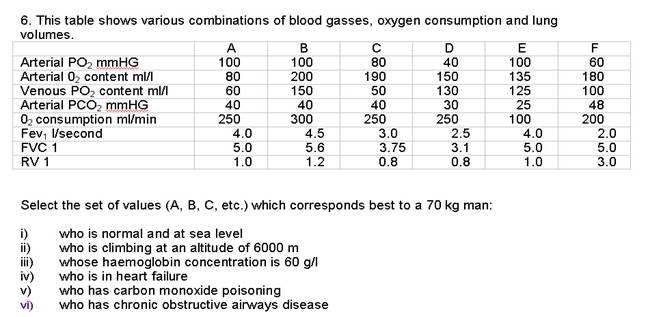Example 2: Data Analysis Question
The following question has been used by Dr Phil Langton, Department of Physiology at Bristol University. Dr Langton believes this is a question which tests students' knowledge at a high level and "is worth 2 essay questions".
What is the cognitive process behind this question? What do students need to know in order to answer the question?

According to Dr Langton: |
|
- the columns of numbers are never presented in this way, so the question cannot be answered by memory alone
- the question requires students to bring together knowledge from two parts of the course, the cardiovascular and respiratory systems, and show understanding of the link between these two systems
- This particular question does rely on students have some memory of (or ability to work out) the 'normal' values for the quantities in the table. In each of the non-normal conditions one would expect to see changes from the normal state.
|
None of them can be answered by looking for only one change - they all result in multiple changes.
- The question requires the student to bring together their knowledge of the normal values and their understanding of the cardiovascular and respiratory system to interpret the data. They must use this to work out what is going on in the systems and then match that with the external conditions that would bring this about.
|
To illustrate further, this is Dr Langton's explanation of condition iv)
C= heart failure.
When the heart begins to fail the volume of blood it can pump is lowered. The amount of oxygen in the blood leaving the lungs is pretty normal (190) but the thing to notice is how little is in the venous blood on its return (50). This is because the tissues of the body are being obliged to extract far more oxygen from what little blood arrives (190-50=140 ml per litre ; compare to normal [column B] 200-150=50 ml per litre).
Can you see any scope for this kind of data interpretation question in your own subject?



